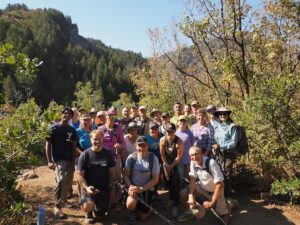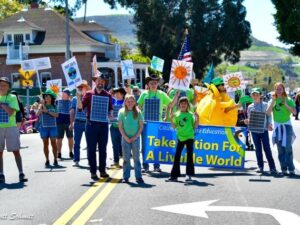
Kai, June, and Lola Guthrie, their mom Kristan Klingelhofer, and CCL Santa Rosa group leader Barbara Moulton appear here with the Sonoma County Board of Supervisors, who passed a municipal resolution supporting CF&D. The Guthrie family has also launched the Schools for Climate Action initiative.
By Philip Finkelstein
A few months ago, we posted an article about a CCL family that lobbied together in Washington, D.C., during our June conference. They also kicked off the Schools for Climate Action Campaign (SCAC) to encourage school boards to pass resolutions acknowledging climate change and endorse carbon pricing. Since then, their campaign has found success and picked up steam—there’s even potential for this school board endorsement initiative to spread across the nation.
The first success
Back in July 2017, Park Guthrie of the Santa Rosa CCL chapter in California sent an email to his local CCL group inquiring about Sebastopol Union School Board members that would be open to hearing his proposal for climate action. In response, Park was put in touch with school board member Lawrence Jaffe—he was a bit of a climate activist himself. Park and the youth-adult team, including his two eldest kids, Kai and Lola, along with Bruce Hagen, met with Lawrence later that month to talk shop and exchange contacts. The stage was set.
The SCAC team quickly set up two more meetings with other school board members over the course of the next month to discuss the proposed resolution, which had been carefully drafted to reflect the agenda and rhetoric of CCL. Allies were made insofar as discussion of their resolution was added to the docket of the next school board meeting. Buckling down, Park and his compatriots prepared for a presentation that would make or break their campaign.

(L-R) Kai, Lola, Park and June Guthrie. “Face masks were not for dramatic effect,” Park said.
The presentation was brief but to the point, gaining them the support they needed—a motion passed to move the resolution to board committee for revising. A month of sweeping wildfires across Sonoma Country heightened anticipation, but the day finally came. On Monday, December 4, Sebastopol Union School Board unanimously passed the Sebastopol Union School District’s (SUSD) Climate Change Resolution, releasing a press statement characterizing it as “one of the strongest climate change resolutions ever passed by a public school board in the nation.” The SUSD resolution received praise all around, providing just the fodder needed to keep the campaign going strong.
Empowering and energizing youth
When asked what it means now that the SUSD resolution is in effect, Park said this marks the beginning of a paradigm shift as climate change is realized to be “a children’s issue and therefore institutions and leaders focused on the well-being and future success of children can no longer remain silent.” He went on to say, “SUSD has an ongoing process by which to focus institutions on responding creatively and boldly to the climate crisis.” The plan involves addressing climate change through curricular and educational opportunities, facility and operational priorities, a reduction in the district’s greenhouse gas emissions, and engagement with local, state, and federal jurisdictions.
Perhaps even more importantly, Park points out that students—youth participants on the SCAC team in particular—feel empowered and energized to make a political difference when it comes to climate change as a result of this resolution. And this, he feels, is the greater success; after all, it’s this generation of children who will be inheriting the planet and protecting it from further destruction. In this respect, the hope is that this resolution will serve to demonstrate to young people across the country that this is their movement, and with a little political will, they can do their part in swaying the decisions of policymakers before they themselves grow up to be the politicians and citizens that lead us into a greener tomorrow.
Building momentum
The story doesn’t end here. Word of the SCAC is spreading as other school districts in California have become engaged in joining the campaign, including the Ross Valley School District (RVSD) which passed their resolution just this month. The Sonoma County Board of Education just passed a strong resolution today, in fact, stating in part, “National, local, and state elected leaders working in a bipartisan fashion to enact carbon pricing policies could substantially reduce or eliminate net human-made greenhouse gas emissions, thereby protecting our current and future students.” Efforts are well underway across the country too, currently as far as Ohio.
Park explains, “School stakeholders in other districts now have an easy, straightforward template to use in order to translate previously private beliefs into individual public statements, which has the power to shift paradigms and build public will for science-based climate policies.” Park is confident there are thousands of school board members across the country who have simply never been asked to speak up, but who will do so gladly now that they have a model to follow.
“With two data points, it’s no longer a blip. Suddenly, there’s a trend-line starting to form,” Park proclaims. Thanks to CCL relationship-building and political will-building techniques, the momentum is picking up steam. With over 10,000 school districts in the country, there’s a lot of work ahead, but if the SUSD and RVSD resolutions are any indication of things come, we have a lot to look forward to.
To learn more, please visit the Schools for Climate Action website.





